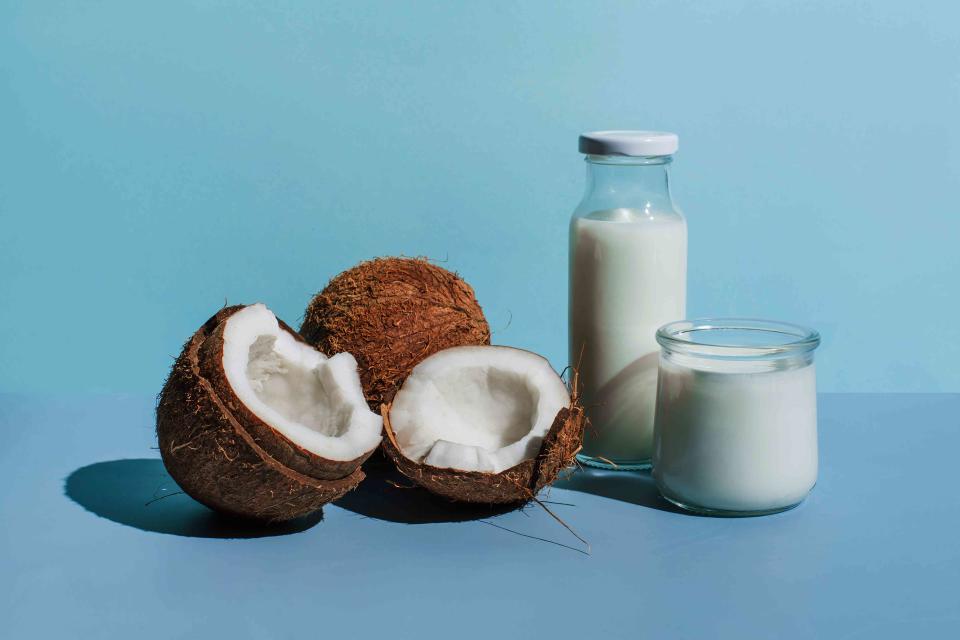Cream of Coconut vs. Coconut Milk: What's the Difference?
Plus, the skinny on coconut cream.

Tanja Ivanova/Getty Images
Coconut trees grow throughout the tropics in countries like Indonesia, India, and Malaysia, but thankfully, coconut products are exported throughout the world. Coconut water, coconut oil, and coconut sugar are just a few popular coconut products that all come from the same versatile plant.
Of the coconut’s many layers, there are two main parts that are edible—the water that sloshes around in the middle, and the white flesh or meat called endosperm. It’s these two parts of a coconut that are usually used to make coconut products, such as coconut shavings, coconut aminos, and many more—the list goes on.
Coconut milk remains one of the most popular coconut goods, but it’s often conflated with cream of coconut. Both can come in a can, and it can be difficult to distinguish between them based on the packaging alone. Here’s what you need to know about cream of coconut vs. coconut milk.
Related: 5 Reasons to Eat More Coconut, According to RDs
What Is Coconut Milk?
Coconut milk is a common non-dairy milk substitute. It’s a white liquid that comes directly from coconut meat, which is broken down. To make coconut milk, coconut meat is grated and mixed with hot water. The mixture is then pressed through cheesecloth to yield smooth, flavorful coconut milk.
Compared to other non-dairy milks, such as almond milk, coconut milk is thicker, more opaque, and higher in fat. So, it’s a better option for replacing whole milk in recipes. It’s also a staple in Asian-style cooking. Recipes for curries, soups, stews, stir fries, and rice dishes often call for canned coconut milk—which is thicker and creamier than coconut milk sold in cartons. Because of its thickness, high fat content, and sweetness, canned coconut milk is also commonly used in baked goods, like cakes, puddings, and ice creams.
While coconut milk is thicker than other milk options, it’s thinner than other coconut products, such as cream of coconut and coconut cream.
What Is Coconut Cream?
When you open a can of coconut milk, there’s usually a thick layer of white cream on the top. This is the natural separation between the solid part of the coconut that’s highest in fat, and its watery liquid counterpart. If you skim off that top layer—which many recipes suggest you do—you’ve stumbled upon coconut cream. In short, coconut cream is made from the richest, most decadent part of mature coconut meat. It can best be compared to condensed milk, though it’s unsweetened and thinner in consistency than cream of coconut.
Related: Wait a Minute, Is Milk More Hydrating Than Water? Here's the Best Time to Swap Water for Milk
What Is Cream of Coconut?
When buying any non-dairy milk alternative, you’ll see labels like “sweetened” or “unsweetened,” which indicates whether added sugar is present to enhance the taste. Canned coconut milk is often unsweetened. Coconut is a fruit, so it has a natural sweetness to it. Plus, it’s creamy and indulgent on its own, nixing the need for added sugar.
However, there are times when you might need some extra sugar in your coconut recipe, and that’s when it makes sense to reach for a can of cream of coconut. Cream of coconut is simply sweetened coconut cream. It’s more processed and contains added sugar, so it’s noticeably creamier and sweeter than both coconut milk and coconut cream. Its taste and consistency make it the best non-dairy substitute for sweetened condensed milk. It’s often used in baked goods, desserts, and drinks. Its most common application, however, is as a mixer for alcoholic drinks, such as piña coladas.
Can You Substitute Cream of Coconut for Coconut Milk?
In sweet recipes, you can substitute cream of coconut for coconut milk. However, they’re not a 1:1 substitute, so you’ll need to make some adjustments to swap them for each other.
To use cream of coconut in a recipe that calls for coconut milk, dilute it with water. You’ll need a ratio of about three parts cream of coconut to one part water. This thins down the consistency of cream of coconut, so you can use it like coconut milk. Keep in mind that cream of coconut contains sugar, so this substitution works best for recipes that call for sweetened coconut milk. Otherwise, you may need to reduce the sweetness elsewhere in the recipe to account for the sugar in cream of coconut.
To use coconut milk in place of cream of coconut, you’ll need to make it thicker (and potentially sweeten it). This can be done by skimming the thick layer of cream off the top of canned coconut milk. To ensure it separates, place a can of coconut milk in the refrigerator overnight. Full-fat coconut milk works best for this. By morning, you should be able to scoop the separated cream, which is essentially coconut cream. To use it like cream of coconut, give it a stir and add an equal part of sugar.
Related: 23 Tropical Cocktails That Make You Feel Like You're on Vacation
In savory recipes, however, cream of coconut and coconut milk aren’t interchangeable. The added sugar in cream of coconut will impart an unwanted sweetness to savory dishes and sauces, so it’s best not to use cream of coconut at all.
For more Real Simple news, make sure to sign up for our newsletter!
Read the original article on Real Simple.

